Deadly earthquake in Italy hits near SIU professor’s summer home
Rescuers hug in front of destroyed building destroyed by the earthquake on Aug. 24, 2016 in Amatrice, Italy. (Manuel Romano/NurPhoto/Zuma Press/TNS)
August 24, 2016
All that separated SIU professor Cinzia Padovani from a 6.2 magnitude earthquake in central Italy was 11 days.
“For me, it’s terrible because I am far away,” Padovani said. “I don’t know where my friends are.”
At 8:36 p.m. Central Standard Time on Tuesday, an earthquake struck in central Italy in the middle of the night, according to The New York Times. The paper reports at least 159 are dead.
Advertisement
Two minutes after the earthquake, a friend messaged Padovani to tell her what happened.
Padovani, a radio, television and digital media professor, is from L’Aquila, Italy, roughly 32 miles from Amatrice, one of the towns that sustained the most significant damage from the natural disaster. She had spent months there at her summer home until returning for the beginning of the semester less than two weeks ago.
The distance didn’t stop her from trying to reach out. She stayed up throughout the night as news unfolded, contacting family and friends, including her son. Some of her friends texted her from their cars, too afraid to go inside their homes.
She said she was glad to hear her family and friends were safe; however, her friend’s colleague was trapped under rubble with her husband and one of their sons in Amatrice. Their other child was found alive on top of the rubble. Padovani had not heard any updates as of Wednesday night.
A series of aftershocks have been felt since the first incident, but Padovani said from what she knows, no one in L’Aquila was killed.
Central Italy was still recovering from a 6.3 magnitude earthquake in 2009 that killed more than 300 people, and Padovani said many buildings were still being repaired from that event.
“My town is in the rebuilding process,” Padovani said. “It is going to be years and years and years.”
Advertisement*
She said many of the buildings are very old and were built much differently than houses in the U.S.
“It’s difficult for the American public to understand,” she said. “All of these constructions, buildings, little towns and villages were built in the middle ages. … Ours are all rocks and stone and cement.”
Padovani said the rebuilding process from here will be hard, and some ancient buildings might be forever lost.
“For those who have lost so much, now it’s going to be a very, very long 10 or 15 years,” Padovani said.
Staff writer Cory Ray can be reached at 618-536-3326, [email protected] or on Twitter @coryray_DE.
To stay up to date with all your SIU news, follow the Daily Egyptian on Facebook and Twitter.
Advertisement









